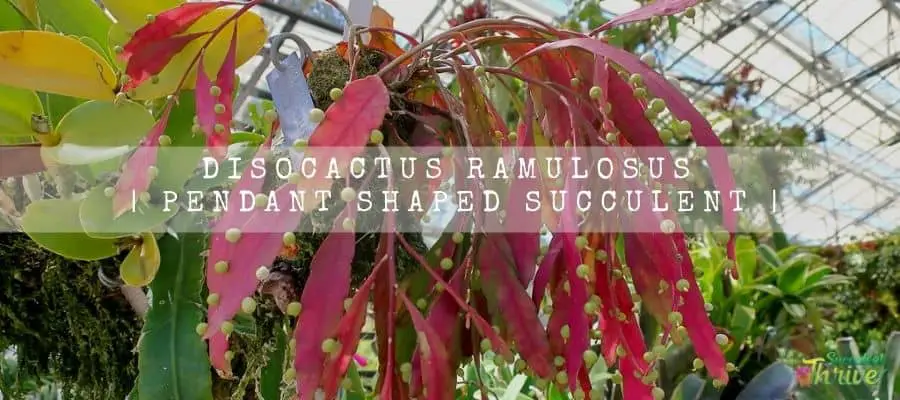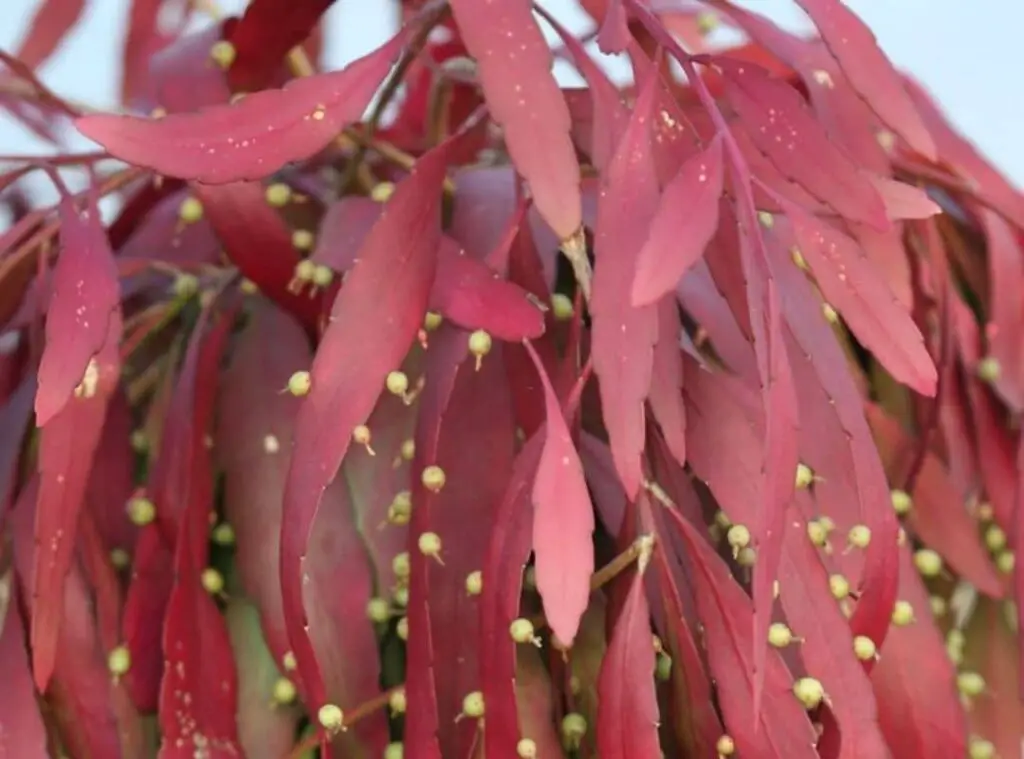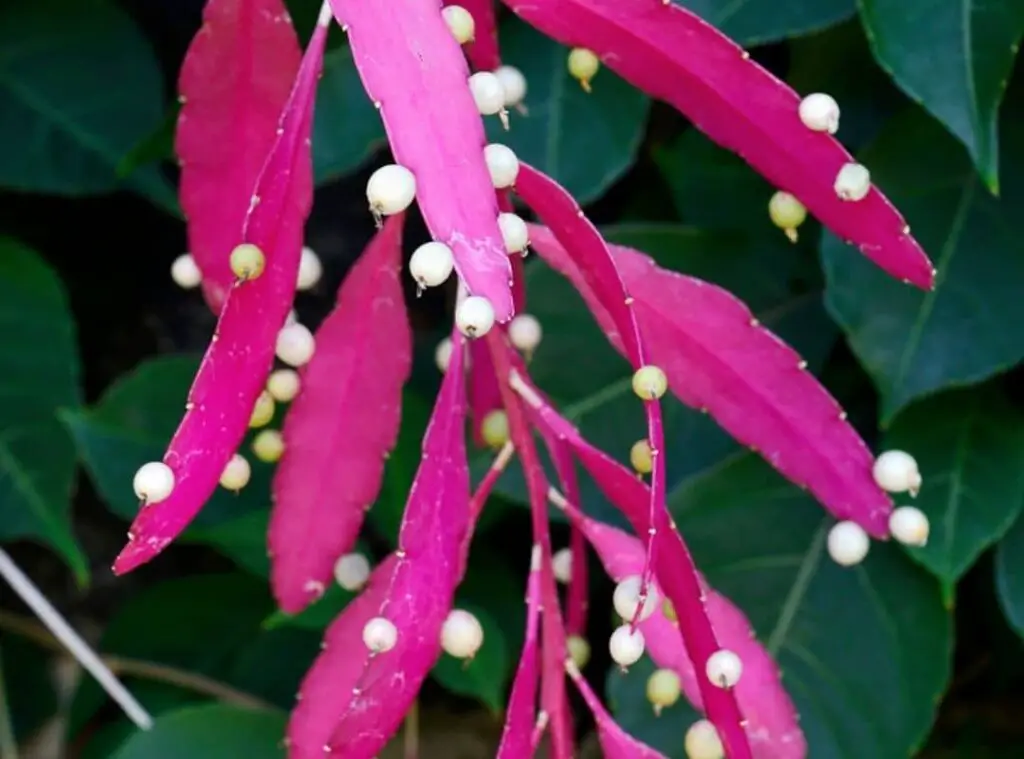Disocactus ramulosus is a widely spread succulent in south and central America.
They need little maintenance to grow from you just like the other succulents. However, it is vital that you provide the right growing conditions for them as only then can they become vibrant in the colors.
You can call Disocactus ramulosus as red mistletoe commonly and they belong to the family cactaceae.
If you are interested in learning about these beauties, you will find this article very informative.

How do I identify Disocactus ramulosus?
As aforesaid, Disocactus ramulosus tend to grow as a shrub epiphyte and you could spot them branching basally.
The stems are reddish in color and tend to take a pendant-like look. Disocactus ramulosus stems are 70 cm in length.
If the plants are properly stressed, you will see how deeper their violet red gets. They produce flowers in greenish or in white colors.
Furthermore, they would transform it into some fruit as well. Disocactus ramulosus fruits will form on the edges of the stems. They would reach a maximum height of 20 inches when they grow to their fullest.
The Disocactus ramulosus flowers would be about 7-12 mm in length. Their diameter would be 10-14mm. Further they could comprise about 6-7 petals as well.
The flowers tend to take the look of a pendant. Besides the aforementioned factors, you could use their fruits to identify the Disocactus ramulosus.
In fact, Disocactus ramulosus fruits would be white or pinkish white in color and they would tend to look like small pearls.
The seeds would be small and black. Disocactus ramulosus has a close resemblance to Rhipsalis lorentziana in terms of its appearance. They tend to grow upright.
Size of the plant
This plants reach a maximum height of 20 inches when they grow to the fullest potential.
Growth rate
They grow in a trailing manner. As such you can grow them in hanging baskets.
One look care guide
| Botanical Name | Disocactus ramulosus |
| Common Name | Red mistletoe |
| Plant Type | Cactus |
| Mature Size | Maximum height of 20 inches |
| Sun Exposure | Filtered sunlight |
| Soil Type | Well-draining |
| Soil pH | Neutral |
| Flower Color | Greenish or white |
| Hardiness Zones | USDA hardiness zone 10. |
| Native Area | South America |
| Toxicity | Non-Toxic |
| Average price | 10 USD |
How do you take care of Disocactus ramulosus?
Light Requirement
In terms of the right light requirements, Disocactus ramulosus would survive well and grow to their best if you grow them in the partial shade.
Filtered sunlight would always work well with these plants as unless intense direct sunlight would create bad impacts on the plants.
On the other hand, if you fail to supply them sufficient sunlight levels, it will badly impact on the flower blossoming of the plants as well as on the vigorous growth of the plants.
Since you grow them as houseplants you need to be mindful of where you locate the plants. Ideally you should place them at least 20 inches ( 50 cm ) away from the windows so that they will be protected from the midday sunlight.
if you have grown them near a glass window, it would be quite harmful for the plants as the heat could multiply from it and it would result in sunburns.
Best would be to provide the same lighting conditions that they get when they grow in the wild.
Temperature and humidity.
Disocactus ramulosus prefers to have warmer temperatures and moderate humid levels to perform well.
The minimum temperature Disocactus ramulosus can withstand is 60 degrees Fahrenheit ( 15 degrees Celsius).
Hence if you are someone who constantly experiences the colder weather conditions, I suggest you grow them indoors right throughout.
Alternatively, you can grow them in a planter outdoors and shift them indoors when any colder weather condition is predicted.

Is it cold hardy?
Disocactus ramulosus are frost tender plants. They cannot tolerate temperatures less than 5 degrees Celsius, particularly during winter.Hence if you have grown them outdoors, you need to shift them indoors.
USDA Hardiness Zone
Disocactus ramulosus prefers to grow in USDA hardiness zone 10. ( 30 degrees Fahrenheit ).
Watering Requirement
When looking after the Disocactus ramulosus, you need to ensure that you do watering properly. The faults you do in watering could be a major reason to kill the plants.
You need to ensure that you do not supply excess water for them at any given time. Hence why it is critical to water them properly.
Generally, Disocactus ramulosus wants to have more water when compared to the rest of other succulents.
Further they need to keep their soil moist too. Having said that, they can still thrive without water for shorter periods also.
Whenever you spot Disocactus ramulosus plants’ topsoil layer is dry during spring and summer, you need to resume watering them.
Always keep in mind to check the soil layer is dry before you water them again. Disocactus ramulosus plants go dormant during fall and winter and during this time, they will have slow growth. Best is to minimize watering them during winter.
Soil Requirement Type / ph.
Disocactus ramulosus can perform well if you grow them in a soil mix which has a greater component of organic material.
Organic material could be peat, sphagnum moss etc. Do not grow them in a normal cactus soil mix as they would not be beneficial for the plant’s growth.
Besides, the draining factor is also critical when choosing the right soil mix to grow them.
Pot size Potting and Repotting.
In terms of selecting the right pot for the Disocactus ramulosus, you should ensure that you are using a porous material plant such as a clay pot or a terracotta pot.
However, you will have to water them more as the water evaporation will be faster in these porous material pots.
You could consider repotting them if you freshy bought them from the stores or if the plants have outgrown in the pot. The purpose of repoptting is to provide them new growing conditions
Where to Plant
You can plant them in hanging baskets as aforementioned. However, when you place them be mindful not to expose them to direct sunlight as it would be harmful for the plants.
Fertilizer and time of year.
Disocactus ramulosus do not have major fertilizer requirements. However, if you consider feeding them, you may use cactus food which is half diluted. Feed them in April to September and once a month.
Dormancy
Disocactus ramulosus are winter dormant plants and they will slow down their growth during dormancy.
Toxicity
Disocactus ramulosus are non-toxic plants for pets such as for dogs, cats and for horses. They are nontoxic for humans as well. The ripe berries are edible and have a sweet taste as well.
Flowers
The temperatures range from 4 degrees Celsius to 18 degrees Celsius which would help the plants to bloom.
When they produce flower buds, do not make any changes to environmental conditions as it will badly affect the flower blossoming of the Disocactus ramulosus cactus. The colors of the Disocactus ramulosus cactus would be greenish white.

Common bugs and illnesses.
Disocactus ramulosus cactus may suffer from scorched and shriveled leaves if you expose them to intense sunlight along with low humidity levels.
In that circumstance you should move the plants to somewhere where they can get some shade and moderate humid levels also.
Limp stems or wilting stems would be another issue that Disocactus ramulosus cactus may go through.
The root cause for this condition would be mainly the faults you do in watering. Root rot for extended periods could also result in this condition.
Moreover, underwatering may also be a factor for this condition. To treat this condition, you need to first observe the roots of the Disocactus ramulosus cactus to see what exactly has caused it.
If a severe root rot has caused the plants for this condition, you need to use the healthy parts of them and propagate them to make new healthy plants. If their soil is withered, you need to immediately resume watering them.
Besides the aforementioned conditions, Disocactus ramulosus cactus are attractive for pests as well.
If you practice improper care tips and expose them to low humidity levels, it will make Disocactus ramulosus cactus more prone towards the pest’s attacks.
Pests such as red spider mites, mealybugs and thrips are commonly spotted pest types which could attack the Disocactus ramulosus cactus.
To remedy them, you need to apply insecticidal soap or neem oil. You can apply it weekly and keep them isolated from the other plants.
If there has been root rot for a prolonged period and if you have not attended to it, chances are that your Disocactus ramulosus cactus may collapse. If you have grown them in a dense potting mix, it could also contribute to this condition.
Special Care tips
Disocactus ramulosus cactus require only an easy-care maintenance from you. All you need to assure is that you expose them to filtered sunlight and provide them with moderate water levels only.
Besides, you can keep checking your beloved Disocactus ramulosus cactus on a weekly basis so that you can identify if your plants are growing healthy or not.
Benefits.
They would be great as trailing plants to grow in hanging baskets.
How to propagate Disocactus ramulosus.
You may use stem cuttings to propagate the Disocactus ramulosus cactus and it is very simple and easy to grow them from the cuttings.
Simply you need to take the cuttings and let them develop calluses for a few days. After that you can grow them in a cactus mix which is slightly moistened.
You can expect them to develop roots within six weeks’ time. You can follow the general care tips to propagate Disocactus ramulosus cactus.
I do not recommend using the seeds as it takes a lot of time to get the results of propagation.
Conclusion
To conclude, I hope you found this article very useful and that now you are very much confident in handling the plants.
Disocactus ramulosus cactus are worth having and it will be soothing to watch them grow well. Happy cultivating with the Disocactus ramulosus cactus!
Read Next : Mistletoe Cactus Flower | The Forgotten Facts |
